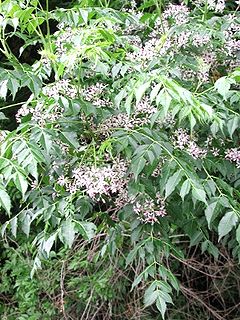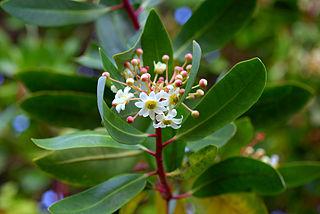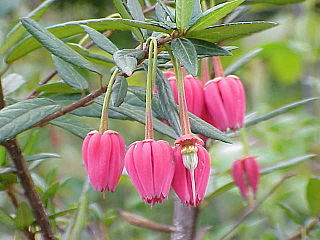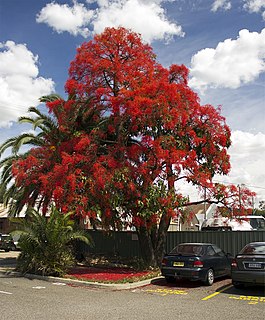
Asterales is an order of dicotyledonous flowering plants that includes the large family Asteraceae known for composite flowers made of florets, and ten families related to the Asteraceae. While asterids in general are characterized by fused petals, composite flowers consisting of many florets create the false appearance of separate petals.

Meliaceae, the mahogany family, is a flowering plant family of mostly trees and shrubs in the order Sapindales.

The Nymphaeales are an order of flowering plants, consisting of three families of aquatic plants, the Hydatellaceae, the Cabombaceae, and the Nymphaeaceae. It is one of the three orders of basal angiosperms, an early-diverging grade of flowering plants. At least 10 morphological characters unite the Nymphaeales. Molecular synapomorphies are also known.

Oxalidales is an order of flowering plants, included within the rosid subgroup of eudicots. Compound leaves are common in Oxalidales and the majority of the species in this order have five or six sepals and petals. The following families are typically placed here:

The Cyperaceae are a family of graminoid (grass-like), monocotyledonous flowering plants known as sedges. The family is large, with some 5,500 known species described in about 90 genera, the largest being the "true sedges" genus Carex with over 2,000 species.

Nothofagus, also known as the southern beeches, is a genus of 43 species of trees and shrubs native to the Southern Hemisphere in southern South America and Australasia. The species are ecological dominants in many temperate forests in these regions. Some species are reportedly naturalised in Germany and Great Britain. The genus has a rich fossil record of leaves, cupules, and pollen, with fossils extending into the late Cretaceous period and occurring in Australia, New Zealand, Antarctica, and South America.

Rhamnaceae is a large family of flowering plants, mostly trees, shrubs, and some vines, commonly called the buckthorn family. Rhamnaceae is included in the order Rosales.

Winteraceae is a primitive family of tropical trees and shrubs including 93 species in five genera. It is of particular interest because it is such a primitive angiosperm family, distantly related to Magnoliaceae, though it has a much more southern distribution. Plants in this family grow mostly in the southern hemisphere, and have been found in tropical to temperate climate regions of Malesia, Oceania, eastern Australia, New Zealand, Madagascar and the Neotropics, with most of the genera concentrated in Australasia and Malesia. The five genera, Takhtajania, Tasmannia, Drimys, Pseudowintera, and Zygogynum s.l. all have distinct geographic extant populations. Takhtajania includes a single species, T. perrieri, endemic only to Madagascar, Tasmannia has the largest distribution of genera in Winteraceae with species across the Philippines, Borneo, New Guinea, Eastern Australia, and Tasmannia, Drimys is found in the Neotropical realm, from southern Mexico to the subarctic forests of southern South America, Pseudowintera is found only in New Zealand, and Zygogynum has species in New Guinea and New Caledonia.

The Atherospermataceae, commonly known as the southern sassafrases, are a family of broadleaf evergreen trees and shrubs. The family includes 14 species in seven genera. The atherosperms are today mostly distributed in the Southern Hemisphere, with two species native to southern Chile and 12 species native to Australasia. Wood is commercially harvested from rainforest species of this family, and is used both in construction and in fine cabinet making.

Elaeaocarpaceae is a family of flowering plants. The family contains approximately 615 species of trees and shrubs in 12 genera. The largest genera are Elaeocarpus, with about 350 species, and Sloanea, with about 120.

Elaeocarpus is a genus of nearly five hundred species of flowering plants in the family Elaeocarpaceae native to the Western Indian Ocean, Tropical and Subtropical Asia, and the Pacific. Plants in the genus Elaeocarpus are trees or shrubs with simple leaves, flowers with four or five petals usually, and usually blue fruit.

Austrobaileya is the sole genus consisting of a single species that constitutes the entire flowering plant family Austrobaileyaceae. The species Austrobaileya scandens grows naturally only in the Wet Tropics rainforests of northeastern Queensland, Australia.

Flindersia is a genus of 17 species of small to large trees in the family Rutaceae. They have simple or pinnate leaves, flowers arranged in panicles at or near the ends of branchlets and fruit that is a woody capsule containing winged seeds. They grow naturally in Australia, the Moluccas, New Guinea and New Caledonia.

Brachychiton acerifolius is a large tree of the family Malvaceae endemic to tropical and subtropical regions on the east coast of Australia. It is famous for the bright red bell-shaped flowers that often cover the whole tree when it is leafless. It is commonly known as the flame tree, Illawarra flame tree, lacebark tree, or kurrajong.

Pittosporaceae is a family of flowering plants that consists of 200–240 species of trees, shrubs, and lianas in 9 genera. Habitats range from tropical to temperate climates of the Afrotropical, Indomalayan, Oceanian, and Australasian realms. The type genus is Pittosporum Banks ex Gaertn.

Asteliaceae is a family of flowering plants, placed in the order Asparagales of the monocots.

Tetratheca is a genus of around 50 to 60 species of shrubs endemic to Australia. It is classified in the botanical family Elaeocarpaceae, now known to encompass the family Tremandraceae, which the genus originally belonged to. It occurs throughout extratropical Australia, and has been recorded in every mainland state except the Northern Territory.

Elaeocarpus angustifolius is species of flowering plant in the family Elaeocarpaceae and occurs from India to New Caledonia and northern Australia. Common synonyms are E. ganitrus and E. sphaericus. It is a large evergreen tree, often with buttress roots, and has leaves with wavy serrations, creamy white flowers and more or less spherical bright blue drupe fruit. In English, the tree is known as utrasum bean tree in India. In Sri Lanka recorded names are woodenbegar and Indian bead tree. It is simply known as elaeocarpus in the Northern Territory of Australia. Other names used for this tree in Australia are Indian oil fruit and genitri. In Hawaii it is known as a blue marble tree.

Elaeocarpus grandis, commonly known as caloon, white quandong, blue quandong, silver quandong, blue fig or blueberry ash, is species of flowering plant in the family Elaeocarpaceae and is endemic to eastern Australia. It is a large tree with buttress roots at the base of the trunk, oblong to elliptic leaves with small teeth on the edges, racemes of greenish-white flowers and more or less spherical blue fruit.

Apodytes is a genus of flowering plants in the family Metteniusaceae. It was formerly either unplaced as to family or placed in the family Icacinaceae. It consists of about 8 species of evergreen trees, from tropical northeastern Australia, New Caledonia, Africa and Asia. The exact number of species has been revised from 3 to 8, according to The Plant List.




















